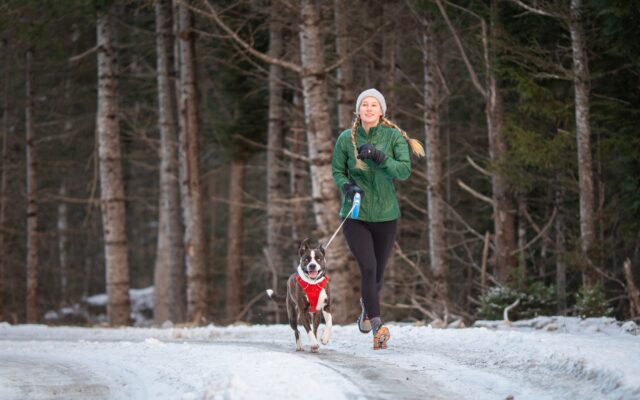
Canicross is catching on in Maine
By Aislinn Sarnacki
For the past four years, my dog has been my trusty hiking companion. Recently, we’ve been trying something new: running together.
A husky mix, Juno is built to run. She’s fast. And together, we’re gaining endurance, mile by mile.
People have been running with their dogs for ages. But as an official sport, cross country running with your dog, or canicross, has only recently gained traction in the United States.
Canicross is a mashup of the words canine and cross-country. It began as a way for sled dogs to train off-season, and over the past few decades, it’s evolved into a stand-alone sport.
The first canicross competition was held in 2000 in the United Kingdom, and has slowly grown since. It saw a jump in popularity in 2019, according to an article in The Guardian, with demand for canicross equipment quadrupling in the U.K., and demand for training classes nearly tripling.

CANICROSS — Aislinn Sarnacki runs with her dog Juno on Dec. 2, along a dirt road in Amherst Mountains Community Forest.
Around that time, the sport took off in the United States, too. In 2018, Brian Thomas, owner of Kenosha Running Company in Wisconsin, founded Canicross USA. Today, the organization promotes the sport throughout the country, with chapters established in more than 20 states, including Maine.
But let’s not get carried away. While canicross is gaining popularity, it’s still a niche sport enjoyed by a small community. The Facebook page for Maine’s chapter consists of just 60 members.
Most people don’t know it exists.
I consider myself dialed into the outdoor community, and I’d never heard of canicross until this past summer. While canoeing across a lake in western Maine, my paddling partner, whom I’d just met, told me about the sport. She’d been encouraged by a fellow hiker to give it a try.
So, is it really as simple as running with your dog? Yes and no.
According to Canicross USA, canicross is a “team sport” with the team consisting of a person and a dog working together. Typically, the person wears a waist belt, while the dog wears a special harness. The two are joined by a bungie-like leash that reduces shock when the dog pulls.
I don’t have this special equipment yet. Juno wears a harness — the same one she wears for hiking. But I simply hold her leash while we run. I actually prefer that she doesn’t pull.
This is fine for people who are just starting out, according to the Canicross USA website. But a true canicross setup, with the proper leash and waist belt, actually increases the team’s speed due to the pulling action of the dog.
It’s a lot like skijoring, a sport in which a dog pulls a person who’s on skis. But in canicross, there aren’t any skis.
I’d be interested in trying the waist belt-elastic leash set up, but not yet. Juno needs more training before I’ll trust her pulling me down a trail or road.
Right now, when Juno runs with me, she often attempts to add other activities into the mix — like sniffing deer poop, splashing in puddles and investigating every single culvert we pass, just in case something interesting lurks inside. She lunges after squirrels, pauses to pee on random objects and occasionally, when the mood strikes her, sprints around me in circles.
Yet more and more often, as Juno grows accustomed to the fast-paced activity, we find a rhythm and simply run together. And boy is that fun.
I think Juno enjoys it, too, based on the squeals of impatience she emits when we arrive at the trailheads to our typical running spots.
Last week, I’m proud to report, we jogged for 10 hilly miles on dirt roads through a local preserve. I was worried the distance would be too much for Juno, but she didn’t seem at all tired by the end of it. I’m starting to wonder if I could ever outrun her.
I originally started running with Juno out of necessity. I needed to give her exercise daily or she became a terror, and I was training for the Down East Relay Race, and after that, a half marathon. I never intended to enter any competitions with her, but now I’m tempted.
There aren’t many canicross races, but I have noticed a few listed close to home. This past November, for example, canicross 2K and 5K races were held at Smith Bridge Preserve in Oxford. And back in May, canicross races were a part of the Trail Festival at Pineland Farms in New Gloucester.
One of the biggest hurdles would be to keep her calm around so many other dogs. But it would be helpful that canicross races commonly have single, staggered starts rather than mass starts.
Whether we ever race together, I think running is good for us. It’s just one more way we have fun together.
Sure, it can be frustrating when Juno wraps her leash around a tree or decides to roll in the snow while I struggle up a steep hill. But it’s worth the extra effort to watch her trot enthusiastically ahead of me, her tail curled and her ears flapping with each stride.